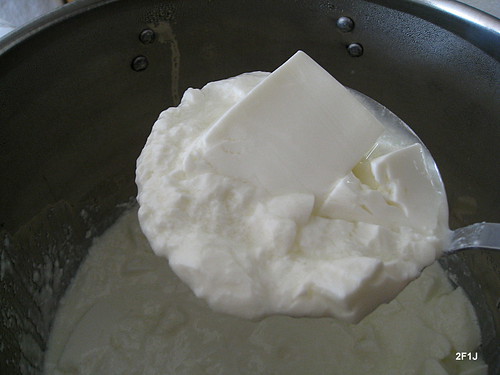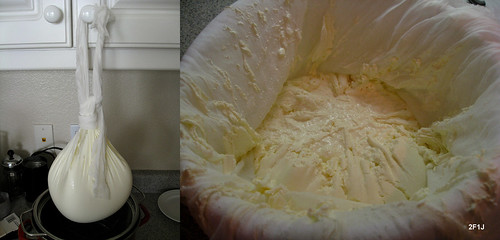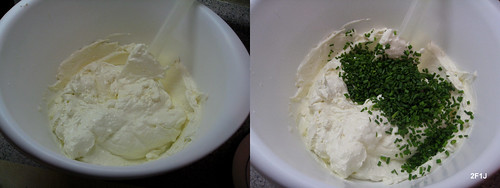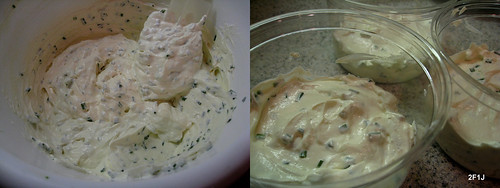The process of making food is simple and extremely complex at the same time. You take some basic ingredients, of course trying to use those that are the freshest and of the highest quality, and with a few, quite mechanical and technical steps they can be transformed into an amazing variety of delicious food. As we both are foodies and scientists simultaneously, there are some kinds of food that hold a deep fascination for us, and we intend to learn a lot more about them in the next few years. Take for example cheese, only one basic ingredient – milk – is needed, and with the help of bacteria or enzymes a fermentation process followed by different ripening processes transformed into such a fascinating diversity of different cheeses worldwide.
To get started and learn about how to make our own cheese at home, we followed the guidance of Ricki Carroll in her excellent book “Home Cheesemaking” to start out with soft cheeses that require less equipment than hard cheeses. We picked Fromage Blanc for our first attempt on preparing a homemade cheese.
“Fromage Blanc” means “White Cheese” and is a European-Style cow’s milk cheese, very similar to German “Quark” (more to come soon about this classical staple in German cuisine that is unfortunately very hard to find in the US). It originated from Belgium and the North of France and is a member of “Fromage Frais” (“Fresh Cheese”). For a fresh, unripened cheese it comes with a surprisingly tasty and creamy flavor, and its low calorie and fat content make it a great substitute for cream cheese.
You need very few ingredients and equipment to make Fromage Blanc. Make sure you buy pasteurized (or even raw) and not ultrapasteurized milk, since your milk needs to still “live”. We ordered several packets of “direct-set Fromage Blanc starter” from Ricki Carroll's online cheesemaking supply store from which we also got a thermometer and a curd knife. Other than that you only need a large cooking pot, a colander, and butter muslin. Since you are dealing with live cultures you want to keep everything very clean to avoid any cross contamination with other bacteria, so we rinsed all equipment with hot water before use.
Pour milk into large cooking pot and slowly heat the milk to 30 degree Celsius (86 degree Fahrenheit) - take your time heating the milk as you don’t want to cause too much “stress”, it took about 10 minutes to reach the desired temperature. Add one packet of direct set Fromage Blanc starter mix #C20 (which contains streptococcus lactis, streptococcus creamoris, lactis biovar diacetylactis bacterial strains, vegetable rennet and malto dextrin) and mix gently but thoroughly. Cover and let sit at room temperature for at least 12 hours, we actually let it sit for 18 hours as we had a lazy Sunday morning getting up late …
Place a colander into another pot or bowl, sterilize your butter muslin in boiling water for 5 minutes and line the colander with it.
By now a nice curd will have formed in your cooking pot, when you push it with your hand you want to feel some resistance and it should also give a nice, clean break when you cut it with your curd knife. In this recipe it is not important that you cut it into smaller curds, but we enjoy doing it anyway as it is a lot of fun. It will also help accelerate the draining process.
Ladle your cut curds into the colander. We let the curds drain for 15 minutes and then tied the ends of the butter muslin up and improvised a little bit: we used the door knob of one of our kitchen cabinets to hang it for draining. We let it drain for 5 hours, checked the consistency but felt it was still too liquid, and let it drain for another 3 hours.
Transfer the drained curds into a bowl. We seasoned them with some cheese salt and cream to taste, mixing thoroughly, and then added some chopped chives. Finally, we transferred our first, homemade Fromage Blanc into smaller containers. Since we got about 2 pounds of cheese that we could hardly all eat ourselves we surprised some of our friends the next day with some of it. When storing the cheese in the refrigerator it will be good for about 1-2 weeks.
Recipe adapted from “Home Cheesemaking” by Ricki Carroll
3.8 L (1 Gallon) pasteurized milk
1 packet direct-set Fromage Blanc starter
Cheese salt
Heavy cream
Fresh, chopped chives














2 comments:
Wow my salivary glands were being stimulated as I was reading, haha. My mother used to make her own miso and I've been wanting to try it myself.. Thanks for the inspiration! :)
Dennis - with your great knowledge of especially japanese food it would be great to see you doing some posts about cooking japanese food. It's one of the cusines we hopefully will soon start to cook more from.
Post a Comment